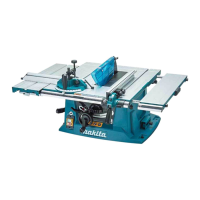
Do you have a question about the Makita MLT100N and is the answer not in the manual?
| Idle speed | 4300 RPM |
|---|---|
| Angle setting range | 0 - 45 ° |
| Cutting depth (max) | 93 mm |
| Cutting depth (45º) | 64 mm |
| Wheels | Yes |
| Product color | Black, Blue |
| Placement supported | Freestanding |
| Input power | 1500 W |
| Weight | 34800 g |
|---|---|
| Blade diameter | 260 mm |
Symbol indicates the need to wear safety glasses for eye protection during operation.
Symbol warns to keep fingers away from the moving saw blade to prevent injury.
Symbol shows proper clearance between the saw blade and riving knife for safety.
Tool is for cutting wood, including straight, bevel, and miter cuts.
Connect tool to a single-phase AC supply matching the nameplate voltage.
Advises wearing ear protection due to operational noise levels.
Covers work area, electrical safety, and general safe practices for power tools.
Emphasizes staying alert, using PPE, preventing unintentional starts, and proper dress.
Proper usage, maintenance, storage, and handling of tools and accessories for safe operation.
Instructions on keeping guards in place and ensuring they are functional.
Explains kickback causes and provides precautions to prevent it.
Explains kickback and provides precautions like body positioning and using safety devices.
Precautions for handling workpieces to prevent binding and kickback, e.g., avoiding twists.
Procedures before operating, like disconnecting power for adjustments and cleaning.
Importance of a well-lit, level area, and removing clutter for safe operation.
Using correct, sharp blades, proper mounting, and avoiding damage.
Using correct blades, keeping them sharp, and safe handling practices.
Inspecting workpieces for foreign materials like nails and screws before cutting.
Guidance on locating and securing the table saw for stable operation.
Instructions on how to store the push stick, rule, saw blade, and other accessories.
Details on the blade guard and sub guard, including their function and maintenance.
How to adjust the cutting depth using the handwheel for cleaner cuts.
Procedure for setting and securing the desired bevel angle using the handwheel.
How to check and adjust the 90° and 45° positive stops for accurate cuts.
Instructions for operating the ON, OFF, and Restart buttons.
How the overload system works and how to restart the tool after tripping.
Steps for installing and adjusting the rip fence for parallel alignment with the blade.
Instructions for extending the right-side sub table using screws.
Instructions for extending the back sub table to the desired length.
How to use the slide table and secure workpieces with the miter gauge clamp.
Instructions on using and removing the anti-kickback pawls for safety.
Details recommended saw blade diameter, thickness, and kerf.
Step-by-step guide for installing the saw blade, including flange and nut.
Notes on checking arbor hole diameter and using the correct ring for the saw blade.
How to align the riving knife with the saw blade and set proper clearance.
Steps to install the rip fence onto the guide rail.
How to check if the rip fence is parallel to the saw blade and adjust it.
Instructions on using push sticks, push blocks, and auxiliary fences for safe cutting.
Guide to building a push block from plywood for safe workpiece feeding.
Instructions for creating an auxiliary fence from plywood pieces.
Detailed steps for performing ripping cuts, including fence setup and feed techniques.
Guidance for performing cross cuts, including removing the rip fence and using supports.
How to use the miter gauge for cross cutting, mitering, and bevel cutting.
How to adjust and secure the miter gauge angle for cutting.
Precautions for securing workpieces and adjusting the distance from the saw blade.
Steps for safely carrying the tool, ensuring it's unplugged and guards are secured.
Instructions for cleaning sawdust and chips from the table saw and guards.
Guidance on lubricating moving parts for optimal performance and service life.
Procedure for checking and replacing worn carbon brushes.
List of recommended accessories for use with the tool, and advice on their use.
